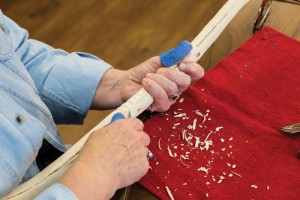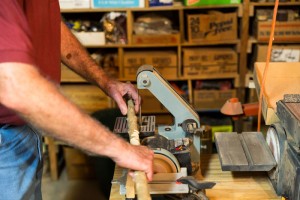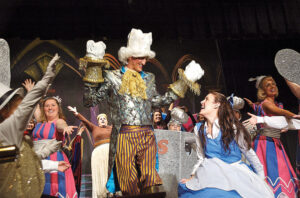
A stick and a knife are tools of their trade
 Story by Tina Tidmore
Story by Tina Tidmore
Photos by Michael Callahan
Walking stick, cane, hiking pole and pilgrim’s staff: just a few of the terms that refer to the humble weight-supporter often associated with disability, the elderly and ancient Biblical characters walking through a desert. At least two St. Clair County woodworkers add creativity to the sticks they find in the woods, giving them eye-appeal in addition to a practical use.
Marvin Little, a retired insurance adjuster, takes a simple approach in his creations. His focus is on using a variety of woods and a variety of handles. He retains the bark and enhances the natural beauty of the stick.
Little’s interest in making canes started when he moved into a new home 15 years ago. While walking through the woods, he noticed some small trees and branches that would make good walking sticks. He has learned many of his techniques through online cane-making clubs where ideas are shared.
His own sharing sparked interest from another would-be cane maker. Cook Springs resident Jackie Stevens, who retired from the banking industry, remembers her interest starting when Little regularly brought his canes to the old St. Clair Federal Savings and Loan in Pell City to show the employees.
Little tried to get her involved in the Logan Martin Woodcarvers group, but she regularly declined. Finally in 2006, “I went to a meeting and became hooked,” Stevens said. Then, with a few unprepared, seasoned sticks Little gave her, she started creating her own canes.
Using a knife, Stevens actually carves shapes and figures into the sticks, including one she worked on of two snakes this summer.
Both Little and Stevens said a love for working with wood was passed down to them in their families. “I enjoy making something with my hands,” Little said. “It’s always a challenge to make something pretty and useful out of wood.”
“I even love the smell of wood,” Stevens said.
Little’s approach is not only to provide something attractive and unique, he likes knowing he is making something with practical use that is helpful to people.
But Stevens’ focus is on adding to her personal wood-carving collection or creating artistic pieces for decoration or display. She has given some as gifts or done commissioned pieces. They are strong enough to be useful, but that’s not her main focus.
Because their canes have different primary purposes, they have different price ranges. He sells his canes at local festivals and is careful not to invest too much time or supplies into them. “You have to make something that will sell at the venue where you want to sell it,” Little said. So his price points are $18 to $28, which generally amounts to enough to cover his expenses. He’s not making any profit or even paying for his time.
Similarly, Stevens isn’t in it for the money, even though she’s sold one at $60 and others up to $400. She started her cane-carving while seeking a stress-reliever. “My shop is the only place that I can completely lose myself with no worries or fears and lose all track of time,” said Stevens. “To me, the entire process from harvesting the wood to applying the final finish is rewarding.”
But she avoids turning it into a job. “I want it to be my idea, my style, no demands,” Stevens said. “I bowed out of the real world and come into my fantasy world.”
In 2006, when Stevens first attended the Logan Martin Woodcarvers, she was the only woman. But now others are involved, and they have taken up carving dolls. “The biggest thing is the friends I’ve gained in the group,” Stevens said.
Cane-making Process
Making a walking cane starts, obviously, with the stick. Marvin Little, who lives just north of Pell City, has used sassafras, hickory, oak, bamboo, sourwood, cedar and many other species. “A lot of it I don’t know what it is because I cut it in the winter when there aren’t any leaves,” Little said.
 Some are branches, but most of the walking canes started as trunks of young trees. Little often turns the root ball into the cane handle. Broken limbs lying on the ground cannot be used because they are weakened by bugs. “It has to be something that feels good in your hand,” Little said.
Some are branches, but most of the walking canes started as trunks of young trees. Little often turns the root ball into the cane handle. Broken limbs lying on the ground cannot be used because they are weakened by bugs. “It has to be something that feels good in your hand,” Little said.
Both Little and Jackie Stevens say “twisties” are highly favored. They are trees that have been twisted into a cork-screw form by vines. “If I find a good twisty in the woods, I’ve got to have it,” Stevens said.
Both Little and Stevens have friends offering them sticks and other wood. “I hate to see wood discarded,” Little said.
The harvested stick must be allowed to season for a year. Then, Little cleans off loose bark. It’s at that point that he decides what he will make with that stick. Some need to be straightened using water and a clamp. Sanding and painting are next. Then he puts on the handles and adds the protective clear coat.
In addition to the joy of creating something attractive, there is the challenge of doing so within the limitations and features each piece of wood has. “The wood has to talk to me,” Stevens said in reference to what she decides to do with it.
Much of the character of a walking cane is in the handle. Little has used a variety of items to create decorative handles, including doorknobs, deer hoofs and elk horns. Even a golf ball has been turned into a cane handle.
The most unusual request Little received was to create a wood-carved human skull as a cane handle. He has been asked to do canes shaped like snakes. But he has refused. Why? Simple. “I don’t like snakes,” he said.
To be functional and stable, the top of the cane must be in the same plane as the bottom, even if the middle is twisted. Also, the height of the cane needs to come up to the person’s wrist. Shorter or longer and it will not provide the stable support needed.
A cane Stevens is most proud of is one that used material from the former Avondale Mills in St. Clair County. “I made this cane in the memory of my Big Daddy McCullough, who worked in the mill all his life,” Stevens said. As the Mill was being dismantled, she asked for some of the remnant material.
She got some wooden thread spools and a 1902 sprinkler head that she made into a cane that she treasures. “I took several of these old spools of various colors, stacked them on each other and ran a quarter–inch thread rod the length of the cane and then put the sprinkler head on top,” Stevens said.
She has agreed to have her canes included in an exhibit at Heritage Hall Museum. Little plans to be selling his canes at this fall’s Homestead Hollow.
But beyond that, they do it just for the joy found in creating a work of art with a knife and a stick.















